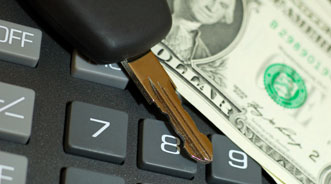As the finance company closed the year with a 16.2-percent jump in active dealers, Credit Acceptance Corp. watched its unit and dollar volumes rise by double figures during the fourth quarter as well, to leave the operation with a healthy gain in consolidated net income for 2013.
Credit Acceptance reported unit and dollar volumes increased 12.6 percent and 11.3 percent as the company originated 46,677 contracts during Q4. For the year, the company originated 202,250 loans, up from 190,023 in 2012.
The company's active dealer level finished 2013 at 6,394 stores, up from 5,319 dealerships a year earlier.
"There's a wide variety of dealerships that would work on our program that works at — very small and independent dealers and some of the largest franchise dealers in the country. We're not targeting one group or the other, and the increases we're seeing are really across all groups," Credit Acceptance chief executive officer Brett Roberts said last week when the company conducted a conference call to discuss its results.
As far as the bottom line, Credit Acceptance indicated consolidated net income for Q4 came in at $65.9 million or $2.80 per diluted share, up from $59.9 million or $2.40 per diluted share during the same period last year.
For all of 2013, the company's consolidated net income totaled $253.1 million or $10.54 per diluted share, compared to $219.7 million or $8.58 per diluted share Credit Acceptance generated in 2012.
Credit Acceptance also mentioned its increase in adjusted average capital of 17.6 percent due to growth in its loan portfolio derived primarily as a result of growth in new consumer loan assignments in recent years, which resulted in the dollar volume of new consumer loan assignments exceeding the principal collected on its loan portfolio.
"The growth in new consumer loan assignments in recent years was the result of an increase in active dealers, partially offset by a decline in volume per active dealer," executives said.
The company went on to pointed out its increase in its cost of capital of 20 basis points arrived primarily due to an increase in the average 30-year Treasury rate, which is used in the average cost of equity calculation, partially offset by a decline in the average cost of debt resulting from the change in mix of its outstanding debt.
Elsewhere, Credit Acceptance acknowledged that a full-year decrease of 60 basis points in its adjusted return on capital came primarily as a result of two factors:
—A decline in the yield on its loan portfolio decreased the adjusted return on capital by 120 basis points due to higher advance rates on new consumer loan assignments.
—An increase in other income increased the adjusted return on capital by 40 basis points primarily due to an increase in global positioning systems with starter interrupt devices fee income resulting from an increase in the fee earned per unit and an increase in vehicle service contract profit sharing income as a result of a new profit sharing arrangement entered into with a third-party provider during 2012.
After looking at all of the numbers, Credit Acceptance chief financial officer and chief accounting officer Kenneth Booth said, "I would say that we continue to be satisfied with the performance. We continue to grow net income, earnings per share, economic profit. We're growing the business in a challenging economic environment, so I'd say we're satisfied with the year."
Evidently dealers who participate in the monthly survey orchestrated by KeyBanc Capital Markets did not see the same conditions in subprime vehicle financing during December as leadership from CarMax noted.
KeyBanc's survey results showed 50 percent of respondents indicated subprime lending availability is loosening and the remainder indicated availability is unchanged. When CarMax conducted its quarterly conference call and announced a new initiative to jump deeper into the subprime financing space, company executives explained how the strategy came as a result of the exact opposite of what KeyBanc's survey participants said.
"In December, CarMax's statement about a pullback they were seeing in subprime financing terms ignited inventory concern," KeyBanc analysts said.
"Our dealer survey and channel check does not seem to support this view and indicated a favorable and improving subprime lending environment in December with 50 percent of respondents who indicated lenders maintained availability of funds to subprime consumers and 50 percent who indicated subprime financing availability was loosening further," they continued.
KeyBanc cited information from CNW Research that noted improving subprime approval rates in December (the latest reported data) at 13.1 percent relative to November's 12.7 percent and October's and September's 12.6 percent.
And CNW's latest Retail Automotive Summary shed even more light on the subject. CNW president Art Spinella indicated that when the firm analyzed used-vehicle buyers, "FICO scores tell a good story about the easing of credit criteria for buying used."
Spinella said nearly 47 percent of all used vehicles financed in December went to consumers with FICO scores of 670 or less.
That availability of financing, especially to consumers with soft credit histories, is projected to boost both used-vehicle performance as well as F&I potential going forward, according to the KeyBanc survey.
Specifically looking at F&I, results showed trends remain favorable as record-high gross profit per unit remains on an increasing trend. KeyBanc found that 50 percent of respondents reported an increase of more $50 in the month of December on a year-over-year basis while 30 percent reported relatively flat results. Only the remaining 20 percent experienced a pullback of more than $50.
"Outlook remains positive largely driven by higher product penetration rates through consistent reviews and training," KeyBanc said.
In the used-vehicle segment, KeyBanc discovered 50 percent of respondents indicated a used-vehicle gross profit per unit increase more than $50 in December on a year-over-year basis. Analysts found that 30 percent indicated gross profit per unit remained the same, and the remaining 20 percent indicated used-vehicle gross profit per unit declined by more than $50 from the same month last year.
"Going forward, we believe headwinds driven by high cost of inventory will stabilize as used-vehicle prices decline in response to improving supply of late-model used vehicles," analysts said.
"We maintain that used car volume will accelerate into 2014 as supply of late-model used vehicles continues to improve," they continued. "Late-model used-vehicle sales have lagged the overall used-vehicle market throughout recovery due to constrained availability as a result of a substantial decline in new-vehicle sales throughout the 2008/2009 timeframe.
"Coming out of the decline, new-vehicle sales have increased at a compound annual growth rate of 12 percent throughout the 2010/2012 timeframe, increasing availability of late-model used vehicles with approximately a two-year lag," KeyBanc pointed out.
"Franchised dealers are likely to benefit going forward as late-model used vehicles tend to re-enter the market through trade-in, allowing franchised dealers first hand opportunity to claim the highly desired inventory," the firm went on to say.
Manheim's Tom Webb acknowledged some finance companies are making what he called "silly loans" to subprime customers, but he's not expecting underwriting standards to tighten quickly in the short-term future.
During his recent quarterly conference call, Manheim's chief economist projected that it will be later this year at the earliest before finance companies make any significant adjustments in loans they're bringing into their portfolios.
"My sense is that there hasn't been a lot of material shift back toward in any way you call tightening," Webb said. "Subprime lending I still say is very loose. For them to pull back a little bit is probably a logical thing to do, but I don't think it's anything material."
In fact, Webb mentioned that he also heard how CarMax is intending to broaden its subprime lending strategy, a development SubPrime Auto Finance News reported here. When asked how overly aggressive strategy might create a possible impact on the subprime market, Webb responded this way.
"Yes, we're starting to get to the point where some people are making some silly loans, and they were not pricing the risk accordingly. Some of those risks you can't even price out right," Webb said.
"But in general I think it may make sense for the lenders to take a little breather in terms of their aggressiveness and see how their portfolios are performing," he continued.
"Today they're performing tremendously," Webb went on to say. "Whether they're concerned where there might be deterioration in portfolio performance in the first and second quarter of next year, yes, they might be a little concerned about that. And if it does happen, they will tighten. But I still think the credit cycle has got longer to run."
That comment prompted analysts to put Webb on the spot. Just how long will plenty of subprime paper fill finance company portfolios?
"They seem to be fairly content to me given their lending practices," Webb said. "I think they always worry because they know what's happening. The capital markets are throwing money at the lenders so lenders are pushing money at the dealers. They know where this game is going to end. I don't think they know they're at the end of the game yet."
"You could have a turn in terms of the aggressiveness with which they're lending certainly by 2015, if not sometime this year with at least a more nuanced stance in terms of lending," he concluded.
The ability of subprime customers to obtain vehicle financing helped the used-vehicle industry finish the year on the upswing as December capped an overall great year for the pre-owned market and pushed the full-year sales total above 40 million units.
Specifically, used-car sales closed 2013 at just under 42 million units, according to CNW Research.
CNW determined the number of financed units came in at 8 percent versus year ago with those obtaining a pre-approved loan climbing nearly 19 percent because of “easier credit criteria,” according to firm president Art Spinella.
Spinella also mentioned the number subprime buyers in December surged 23 percent higher versus a year earlier and 10.5 percent above November.
Spinella went on to mention that the number of deep subprime purchasers (individuals with FICO scores below 550) swelled nearly 17 percent year-over-year to constitute a bit more than 19 percent of all used sales in December.
CNW also reported that for the whole year, franchised dealers took nearly 37 percent of all used sales, while independents notched a 34.6-percent share. Private party sales made up for the difference at 28.4 percent.
And 2013 closed out with a bang, as 3.284 million used vehicles were sold during December.
This represents a 4.2-percent year-over-year climb and a 6-percent rise from November.
The total value for December, excluding taxes, upfitting and aftermarket products, came to $30.8 billion.
Year-over-year upticks in transaction price contributed to this number, as the average used-car sale transaction price came in at $9,370 in December. This was down about a third of a percent versus November but was 4.2 percent ahead of the same month a year ago, according to CNW.
Which used vehicles were flying off the lots in December?
Just under a quarter (24.54 percent) of the total vehicles sold in December were 1- to 5-year-old models, due in part to increasing inventory in this age range, CNW reported.
This is up slightly from 24 percent in November and 22.86 percent during the same period of 2012.
Due to seasonality, consumers were more interested in crossovers, SUVs and pickups this December.
CNW pointed out that used passenger car sales continued to slide downward, as the larger models rose in popularity
As for who got the largest piece of the used-car sales pie in December, the Big 3 sold 60 percent of total used vehicles last month.
Asian bands notched 34.3 percent of used sales in December. On the other hand, the share European brands fell to a 5.7 percent share in December.






